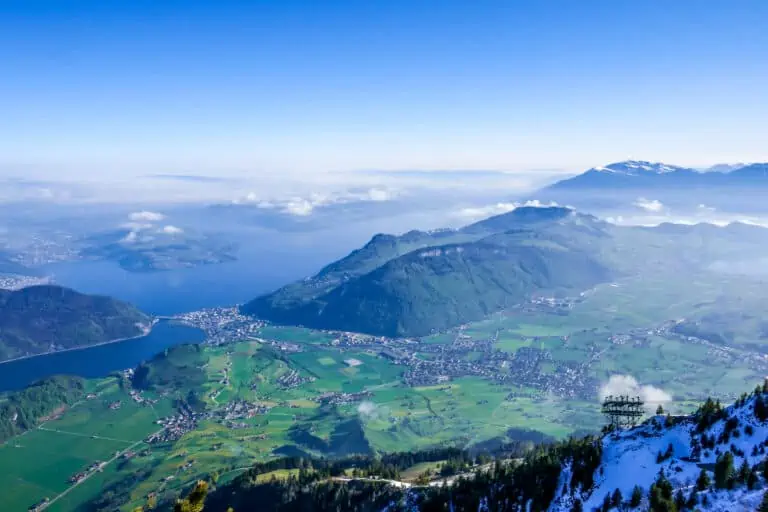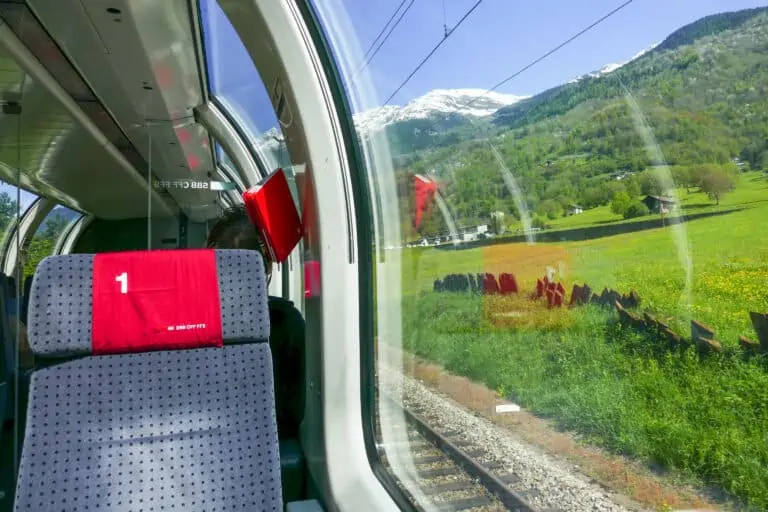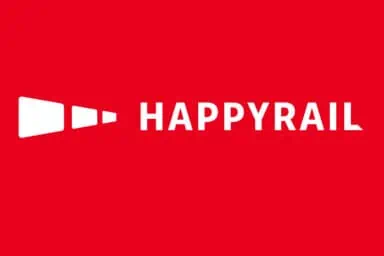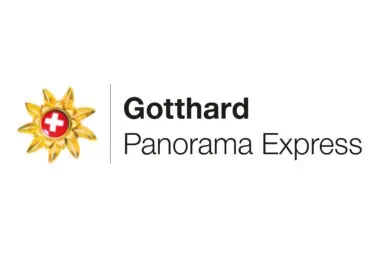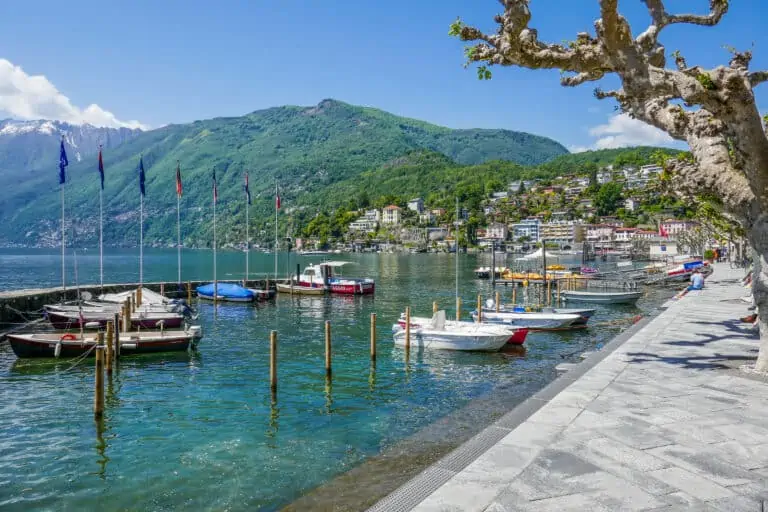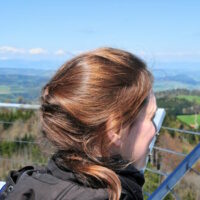Quick intro about the Gotthard Panorama Express ride 
The route starts (or ends) in Lucerne in Central Switzerland, in the northern half of the country. The climate is relatively cool and German is the official language.
You start off with a relaxed boat trip across Lake Lucerne. After that, a panoramic train takes you along the famous Gotthard mountain route to Lugano in the south of Switzerland. The climate is mild enough to grow palm trees here. Culture and language are Italian.
Of course, the Gotthard Panorama Express boat and train operate in the opposite direction too: from Lugano to Lucerne.
Gotthard Panorama Express prices, tickets and reservations explained 
Gotthard Panorama Express 2024 ticket prices
| Price 2nd class | More information | Applies to the following ticket(s) |
|---|---|---|
| CHF 24 | more info and prices | Swiss Travel Pass or Swiss Travel Pass Flex 1st class + train reservation (CHF 24) |
| CHF 41 | more info and prices | Swiss Travel Pass or Swiss Travel Pass Flex 2nd class + train reservation (CHF 24) + discounted upgrade ticket for 1st class train seats (CHF 17) |
| from CHF 73 | more info and prices | Swiss Half Fare Card + train reservation (CHF 24) + discounted Saver Day Pass 1st class (from CHF 49) |
| from CHF 112 | more info and prices | Saver Day Pass 1st class (from CHF 88) + train reservation (CHF 24) |
| CHF 91.50 | more info and prices | Swiss Half Fare Card + train reservation (CHF 24) + discounted point-to-point ticket 2nd class for the boat (CHF 26.50) + discounted point-to-point ticket 1st class for the train (CHF 41) |
| CHF 159 | more info and prices | Full-fare point-to-point ticket 2nd class for the boat (CHF 53) + train reservation (CHF 24) + full-fare point-to-point ticket 1st class for the train (CHF 82) |
The tickets and reservations you need in detail
You need several things for the boat and train of the Gotthard Panorama Express:
- Boat:
- A 1st or 2nd class ticket or rail pass.
- You don't need seat reservations. You can reserve a table in the restaurant if you want.
- Train (which only has 1st class seats):
- A 1st or 2nd class ticket or rail pass. If you have a 2nd class ticket or rail pass, you'll also need an upgrade ticket for the train as it has 1st class seats only. An upgrade ticket for the train ride Flüelen-Lugano costs CHF 34. It's discounted for Swiss Travel Pass (Flex) and Swiss Half Fare Card holders: CHF 17.
- A surcharge or supplement: CHF 24. This includes the train seat reservations and the extra services. The surcharge must be paid on top of whichever pass or ticket you travel with. You can best book the Gotthard Panorama Express supplement well in advance, because reservations can run out. Reservations for the 2024 season can be made from March 2024.
2024 Gotthard Panorama Express prices with a Swiss Travel Pass or Swiss Travel Pass Flex
If you have a 1st class Swiss Travel Pass or Swiss Travel Pass Flex, you don't need additional tickets for the Gotthard Panorama Express. You only have to pay the obligatory train reservation supplement (CHF 24). With a 2nd class pass, you also need a discounted upgrade ticket to 1st class for the train (CHF 17).
2024 Gotthard Panorama Express prices with a Swiss Half Fare Card
Swiss Half Fare Card plus discounted 1st class Saver Day Pass
With a Swiss Half Fare Card, the Gotthard Panorama Express journey realistically costs at least CHF 73.
The above price is based on:
- a discounted 1st class Saver Day Pass for the lowest possible fare (from CHF 49)
- the obligatory train reservation (CHF 24)
Swiss Half Fare Card + discounted 2nd class Saver Day Pass + upgrade ticket
Instead of a discounted 1st class Saver Day Pass, you can buy a discounted 2nd class Saver Day Pass (from CHF 29), plus a discounted upgrade ticket for the train (CHF 17). At a total minimum price of CHF 70, this is only slightly cheaper than the 1st class Saver Day Pass option.
However, the 1st class Saver Day Pass allows you to make the entire ride in 1st class, including the boat. So if you can find a low-priced 1st class Saver Day Pass for your travel date, that's definitely what we recommend!
Swiss Half Fare Card + discounted point-to-point tickets
A discounted Saver Day Pass is normally the cheapest option, provided that you purchase it several months in advance. Alternatively, you can buy normal discounted tickets with your Swiss Half Fare Card. The ride will then cost CHF 91.50 in total. This is based on:
- a discounted 2nd class ticket for the boat (CHF 26.50). You can buy a 1st class boat ticket instead of course.
- a discounted 1st class ticket for the train (CHF 41)
- the obligatory train reservation (CHF 24)
Discounts offered by other rail passes
Apart from the Swiss Travel Pass (Flex) and the Swiss Half Fare Card, several other passes provide discounts for the Gotthard Panorama Express as well. Find a full overview here.
2024 Gotthard Panorama Express prices without a rail pass
1st class Saver Day Pass
If you don't have a rail pass, the lowest possible price of the Gotthard Panorama Express realistically is CHF 112 one way.
The above price is based on:
- a 1st class Saver Day Pass for the lowest possible fare (from CHF 88)
- the obligatory train reservation (CHF 24)
2nd class Saver Day Pass + upgrade ticket
Instead of a 1st class Saver Day Pass, you can buy a 2nd class Saver Day Pass and an upgrade ticket for the train. The total price will then be at least CHF 110, based on:
- a 2nd class Saver Day Pass for the lowest possible fare (from CHF 52)
- an upgrade ticket for 1st class train seats (CHF 34),
- the obligatory train reservation (CHF 24)
This is only slightly cheaper than the 1st class Saver Day Pass variant. But with a 1st class Saver Day Pass, you're also allowed to sit in the 1st class boat compartment.
Full-fare point-to-point tickets
A Saver Day Pass is usually cheaper than regular tickets, provided that you buy it several months in advance. If you can't find an economical Saver Day Pass for your travel date, you should buy normal point-to-point tickets instead.
The Gotthard Panorama Express ride will then cost at least CHF 159, based on:
- a 2nd class ticket for the boat ride (CHF 53). Of course, you can opt to buy a 1st class ticket for the boat instead.
- a 1st class ticket for the train ride (CHF 82)
- the obligatory seat reservation (CHF 24)
Get your tickets, reservations or tours 
Offered by HappyRail: www.happyrail.com
- Excellent prices in all currencies. No additional fees.
- Extra Support: if you buy here, MySwissAlps can also assist if you have questions about your order.
- Experienced team of train travel experts
Offered by Swiss Activities: www.swissactivities.com
- Easy, online, free cancellation in most cases
- Extra Support: if you buy here, MySwissAlps can also assist if you have questions about your order.
Offered by Gotthard Panorama Express: www.gotthard-panorama-express.ch
- The operator of the Gotthard Panorama Express
- No Extra Support: if you buy here, MySwissAlps cannot assist if you have questions about your order.
Promotions 
Scenic rail journeys (with guaranteed seat reservations), self-drive holidays, journeys to famous mountain peaks, and more. Choose your preferred hotels, number of nights, and excursions in each town. Apply the promo code AFFMYSWISSALPS for a 5% discount.
Discounted train and boat rides with your rail pass 
The rail passes below offer free or discounted travel on the Gotthard Panorama Express boat and train. This does not include the additional reservation fees for the train.
| Pass | Discount |
|---|---|
| Day Pass |
Free:
Seat reservations: no discount. |
| Eurail Global Pass |
Free:
Lucerne to Flüelen (boat): 50% discount. Seat reservations: no discount. |
| Interrail Switzerland Pass |
Free:
Lucerne to Flüelen (boat): 50% discount. Seat reservations: no discount. |
| Saver Day Pass |
Free:
Seat reservations: no discount. |
| Swiss Half Fare Card |
Discount 50%:
Seat reservations: no discount. |
| Swiss Travel Pass |
Free:
Seat reservations: no discount. |
| Swiss Travel Pass Flex |
Free:
Seat reservations: no discount. |
| Tell-Pass Winter |
Free:
Göschenen to Lugano: no discount. Seat reservations: no discount. |
| Ticino Ticket |
Free:
Arth-Goldau to Airolo (train): no discount. Lucerne to Flüelen (boat): no discount. Seat reservations: no discount. |
The Gotthard Panorama Express route explained, with map 
The journey is explained from north to south. You can travel in the opposite direction too.
Section 1: Lucerne to Flüelen by boat
You will board a historical paddle steamer or motorboat in Lucerne. The Alps pass by slowly while you enjoy lunch in the ship restaurant (this is optional). The trip starts with views of the city of Lucerne and Mount Pilatus. A bit further on you can see Mount Rigi on your left; a beautiful area to hike.
Between Brunnen and Seelisberg, the boat will turn right into the southern end of Lake Lucerne: the Urnersee. You're getting closer to the higher peaks now, and steep forested rock walls rise up from both sides of the lake. The next destination of the trip, the snow-capped peaks surrounding the Gotthard Pass, can already be seen from here.
You will pass the Tell's Chapel on your left. It marks the place where, according to the legend, Wilhelm Tell escaped from the boat of the Austrian bailiff Gessler. His escape allowed him to kill Gessler a bit later. That paved the way to the formation of the Swiss Confederation on August 1, 1291. This happened at Rütli, a meadow on the opposite side of the lake. August 1 is still the Swiss national holiday.
Nearly 3 hours after departing from Lucerne, you will reach the village of Flüelen.
Section 2: Flüelen to Göschenen by train
The boat trip has come to an end. After a 1-minute flat walk to the station, your journey continues by train. The next 2.5 hours will be full of mountain scenery and impressive railway engineering of the famous Gotthard railway.
This second section of the Gotthard Panorama Express route runs through the valley of the river Reuss. The valley floor is relatively wide in the beginning, but once you have reached the village of Amsteg, it is very narrow. It's interesting to see how the river, railroad, expressway, and local road all fit into the little available space.
Another challenge for the trains is that they have to gain a lot of altitude in a short distance: about 670 m in just 30 km. In order to make that possible without slow cogwheel trains, several spiral loops have been carved in the rocks in order to lengthen the railway. That becomes really obvious when you're passing the village of Wassen and its little white church three times, because of the two loops here.
The train then reaches the entrance of the Gotthard tunnel in the village of Göschenen, at an altitude of 1106 m.
Section 3: Göschenen to Lugano by train
The train continues into the tunnel, which dates back to 1882. There is a light show inside the 15 km-long tunnel.
Airolo, at the other side of the tunnel, is the highest point of the route at 1141 m. You have passed the highest peaks of the Alps, and you may encounter entirely different weather here. You're now in the canton of Ticino. Language and culture are no longer German, but Italian.
The climate is considerably milder and drier here, but still there are interesting variations between northern and central Ticino: the valley floor has 3 different levels and 3 different climates.
The first section has an altitude of around 1000 m. The second section starts north of Faido with an altitude of around 700 m. Just before Giornico, the train reaches the lowest level: under 400 m. It is considerably warmer here. You're now in a wine-growing area, and you'll see some palm trees for sure! Several spiral loops help the train descend to this level.
In Bellinzona, you can see one castle on the right and two on the left. If you get off here, you can switch trains for Locarno. The lowest point of the route at 230 m is just south of Bellinzona. A bit further you can see the Lago Maggiore (the lowest place in Switzerland) and Locarno on the horizon.
Fast trains take the 15.4 km long Ceneri Base Tunnel here, but the Gotthard Panorama Express takes the classic route to its destination Lugano, in the south of the Ticino.
Map with the Gotthard Panorama Express boat and train route
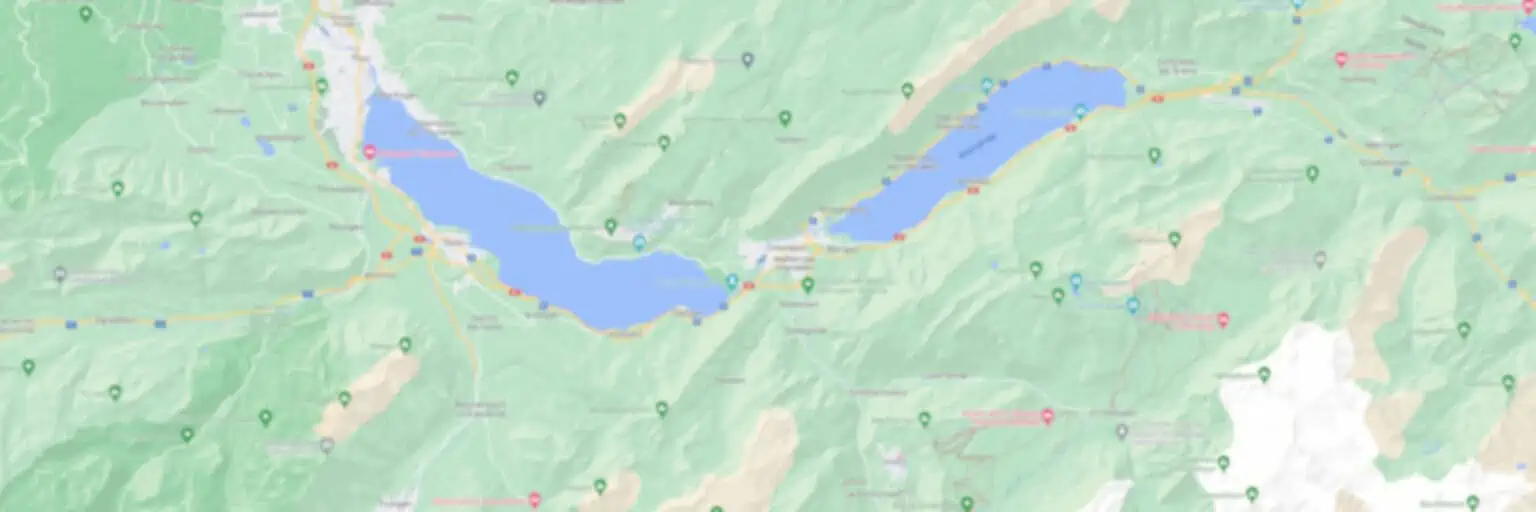
Operation dates, schedules and timetable 
Gotthard Panorama Express: 2024 operation dates
The Gotthard Panorama Express train and boat operate daily from 20 April to 20 October 2024, excluding Mondays. Please check again later for further dates.
Planning the Gotthard Panorama Express journey with the timetable
You can consult the Gotthard Panorama Express schedules here. Or find each section in the Swiss timetable:
- Boat section Lucerne-Flüelen: use the "Settings" to select boats as the only means of transport. Find more boat details here.
- Train section Flüelen-Lugano: the timetable presents the quickest route, which mostly is not the Gotthard Panorama Express route. Add "Göschenen" as via-station. Trains labeled "PE" ("Panorama Express") are the Gotthard Panorama Express trains.
Best months for the Gotthard Panorama Express 
The ride can be made from mid April to mid October. Annika and I favor April to early June. That's because of the fresh spring scenery, the snow-capped peaks, and the bigger contrast between the climate in the north and the south.
Concerning other months:
- Weather in July and August can be wonderful. This is especially nice for the boat ride, as mild temperatures allow you to sit outside.
- September to mid-October is great. It's quieter than in summer and you can enjoy the early autumn colors.
- The Gotthard Panorama Express doesn't operate from mid-October to mid-April.
Weather advice and forecasts 
Clear skies and mild temperatures are best for a Gotthard Panorama Express trip. This type of weather allows you to enjoy the boat ride from the outdoor deck. The scenery along the train route is prettiest in sunny weather too.
As it's recommended to book your train seats early, you can't tell what weather will be like at your travel date. But the ride will be special and comfortable in any case.
You don't have to reserve seats for the boat section. So if forecasts don't look good, you can always choose to travel by train instead of boat between Lucerne and Flüelen.
Current 5-day forecasts for Göschenen (halfway on the train route)
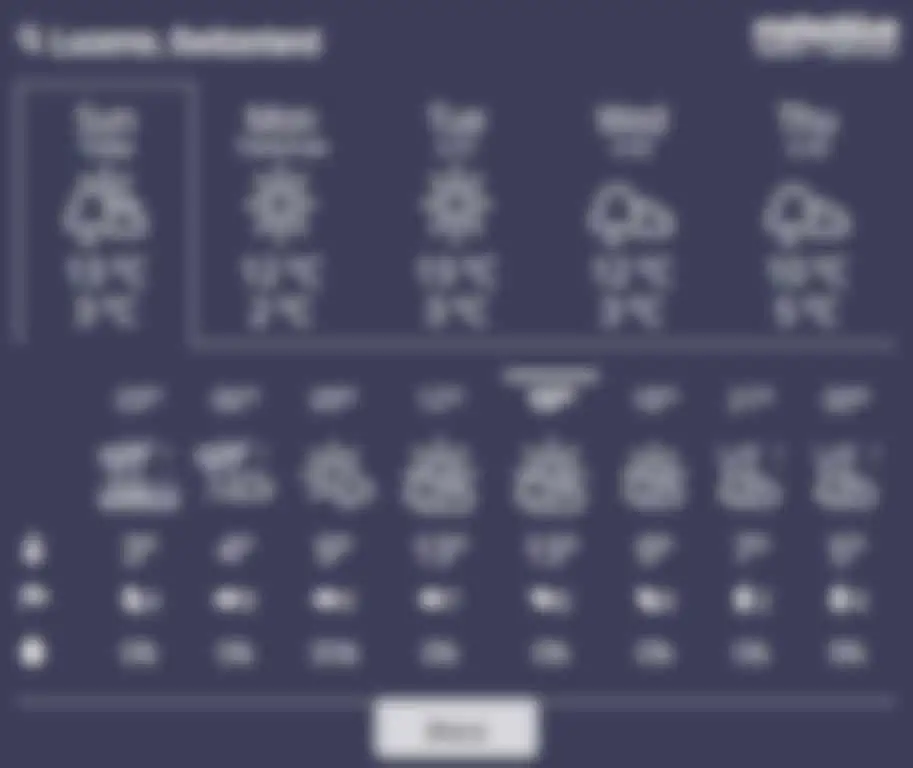
The best side to sit on for the boat and train
If there are few passengers on board and you can move around in empty seats that are not reserved, these are the suggested sides for each section of the route:
- Section 1, Lucerne-Flüelen (boat): you can sit anywhere on the boat. Seats are generally not reserved. Exceptions can apply to reserved seats in the ship restaurant. But the views are great from all sides!
- Section 2, Flüelen-Göschenen (train): the left side of the train offers a slightly better view to our taste.
- Section 3, Göschenen-Lugano (train): the view is a bit better from the right side of the train.
What to expect on board the Gotthard Panorama Express boat and train
The boat
The large steamship offers 1st and 2nd class seats in indoor and outdoor sections. It has a restaurant to have lunch.
The train
The Gotthard Panorama Express train has these features:
- There are 1st class carriages only. The coaches have large panoramic windows, offer free WiFi, and are air-conditioned.
- In addition, there’s a car with opening windows specifically for photographers.
- The multilingual guide on board explains about highlights along the route.
- Snacks, drinks, and cold platters can be purchased. You’ll be serviced at your seat.
- You’ll get an extensive information brochure and a tasty goodbye surprise.
Other train options to travel on the same route
The route of the Gotthard Panorama Express is serviced by regular trains and boats too. These are the train alternatives:
- The Treno Gottardo is a direct train connection that runs several times a day between alternately Basel-Locarno and Zurich-Locarno. You can board it in Lucerne or in nearby Arth-Goldau. If you travel from or to Lugano, a change in Bellinzona is required. The total travel time by Treno Gottardo between Lucerne and Lugano is 3h10. The Treno Gottardo operates on the historic mountain route and offers two bistro zones with snack and beverage vending machines.
- There are other regional trains. Most of them require you to change trains at least once along the way.
- The quickest connections are offered by trains that use the long Gotthard Base Tunnel. A journey Lucerne-Lugano through the tunnel takes just 1h40 to 1h50. The 57 km long Gotthard Base Tunnel is the longest railway tunnel in the world. It opened in 2016 and provides a much quicker way to reach Italy and the south of Switzerland from the north.
My suggestions for variations, side excursions and round trips
Alternative travel modes
There are many variations on the standard Gotthard Panorama Express route. My top picks:
- Bus and train: skip the boat, and instead take a train from Lucerne to Küssnacht am Rigi, and then a bus along the lake via Vitznau to Brunnen. In Brunnen, you can take a train to Flüelen to pick up the Gotthard Panorama Express train there.
- Train all the way: skip the boat, and instead take a train from Lucerne to Arth-Goldau. Board the Gotthard Panorama Express train there.
- Boat, coghweel train and panoramic train: take a boat to Vitznau, then the cogwheel train to Mount Rigi and down to Arth-Goldau. Board the Gotthard Panorama Express train there. This trip offers even more variation than the main route, but is less convenient if you have a lot of luggage.
A 1-day Gotthard Panorama Express return trip from/to one base
If you’re based in or near Lucerne or Lugano, you can make a round trip and return to your base town in 1 day. I feel it’s a bit too much to have the full Gotthard Panorama Express experience by train and boat twice in one day. So it’s more realistic to take the Gotthard Panorama Express boat and train one way, and travel just by train the other way. The options are:
- a regional train via the Gotthard mountain route
- a fast train, crossing the Gotthard Base Tunnel
I think it’s interesting to experience the difference in travel time between the Gotthard Panorama Express on the classic route and high-speed trains (up to 250 km/h) on Gotthard Base Tunnel route.
The Gotthard Panorama Express and other scenic trains
Gotthard Panorama Express or other Swiss scenic trains: how to choose
The Gotthard Panorama Express is not as well known as some other scenic trains, such as the Glacier Express and Bernina Express. Still, this 5.5-hour trip is one of the best scenic journeys that Switzerland has to offer for these reasons:
- It’s not only a train. You’ll also travel by boat, which makes it an entirely different, slow-paced experience.
- The climate and culture contrasts between Lucerne and Lugano are striking.
- It’s an ideal way to transfer between Central Switzerland and the Ticino.
Combining the Gotthard Panorama Express and the Glacier Express
It’s possible to combine parts of the Glacier Express and Gotthard Panorama Express. The Glacier Express stops in Andermatt. From there, a 10- to 15-minute ride in a cogwheel train gets you to Göschenen, which is a stop of the Gotthard Panorama Express.
The below routes can be done in one day. Check the timetable when planning: you may need to leave early to catch the panoramic trains, and in low season options can be limited.
- Zermatt to Lucerne: Zermatt – Andermatt (Glacier Express), Andermatt – Göschenen (cogwheel train), Göschenen – Lucerne (Gotthard Panorama Express);
- St. Moritz to Lugano: St. Moritz – Andermatt (Glacier Express), Andermatt – Göschenen (cogwheel train), Göschenen – Lugano (Gotthard Panorama Express);
- Lugano to Zermatt: Lugano – Göschenen (Gotthard Panorama Express), Göschenen – Andermatt (cogwheel train), Andermatt – Zermatt (Glacier Express);
- Lucerne to Zermatt: Lucerne – Göschenen (Gotthard Panorama Express), Göschenen – Andermatt (cogwheel train), Andermatt – Zermatt (Glacier Express).
Combining the Gotthard Panorama Express and the Bernina Express
If you end your journey in Lugano, you can pick up the Bernina Express bus to Tirano and train to St. Moritz the next day.
Combining the Gotthard Panorama Express and Voralpen Express
If you end in Lucerne, you can travel by Voralpen Express to St. Gallen. This can even be done the same afternoon.
Another option is to switch trains in Arth-Goldau. Both the Gotthard Panorama Express train and the Voralpen Express train can be boarded here.
Combining the Gotthard Panorama Express and the Centovalli Railway
The Gotthard Panorama Express starts or ends in Lugano. It’s a short ride between Lugano and Locarno. Locarno is where the Centovalli Railway starts or ends.
Luggage transportation on the Gotthard Panorama Express
Your luggage can be transported for free between Lucerne and Lugano. Details:
- This service is only for individual travelers, not for groups.
- The service is only available for the official Gotthard Panorama Express, not for alternative trains or boats on this route.
- A weight limit of 23 kg per piece of luggage applies.
- You should hand in your luggage no later than 10 minutes before departure.
- Drop-off and pick-up points are Pier 1 of the Lucerne boat dock, and sector D on the train at the Lugano station.
Gotthard Panorama Express FAQ
-
What’s the best leg of the route?
It’s the contrast between the two climates and cultures, and between the train and boat sections, that make the entire trip worthwhile. I only find the last leg between Bellinzona and Lugano a bit less interesting.
-
Is the Gotthard Panorama Express worth it?
Yes. If you value the views along the way more than a quick trip, I recommend that you travel over the Gotthard mountain route (either by Gotthard Panorama Express or by Treno Gottardo). If you use the fast trains that cross the Gotthard Base Tunnel, you’ll miss out on part of the remarkable scenery.
Choosing the Gotthard Panorama Express for this journey is extra special because of the steamboat. The train is a wonderful experience too due to its panoramic windows, reserved comfortable seats, catering, and the information provided by the staff and the intercom.
That’s why Annika and I think that the Gotthard Panorama Express provides the most complete, diverse, and comfortable way to enjoy this route.
-
Can I choose the side of the train when making reservations?
Yes, in some cases you can. If you can select seats from a plan of the coach, and the driving direction is indicated, you’ll know at which side you’ll be seated.
Other websites of interest
- www.uri-swiss.ch: about the Gotthard Base Tunnel
- www.sob.ch: the Treno Gottardo
Schedules
- www.gotthard-panorama-express.ch: Gotthard Panorama Express timetables
Prices
- www.gotthard-panorama-express.ch: Gotthard Panorama Express ticket and reservation prices
Itineraries including the Gotthard route 
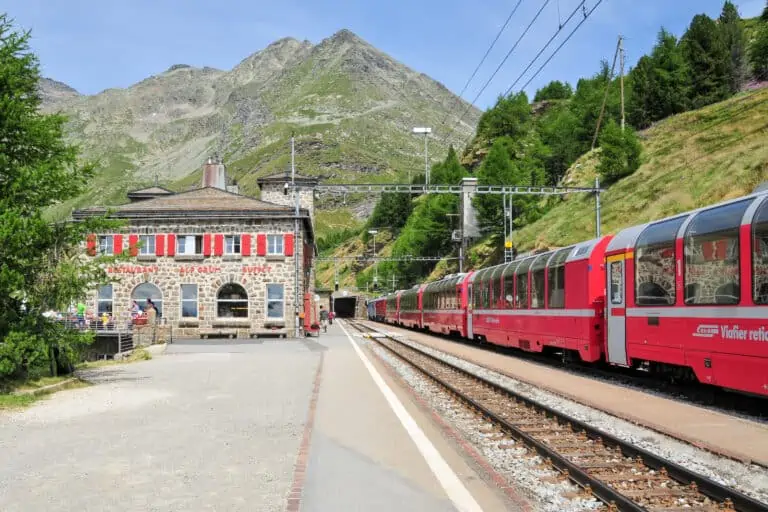
Ultimate scenic trains
Our info about connecting scenic trips 
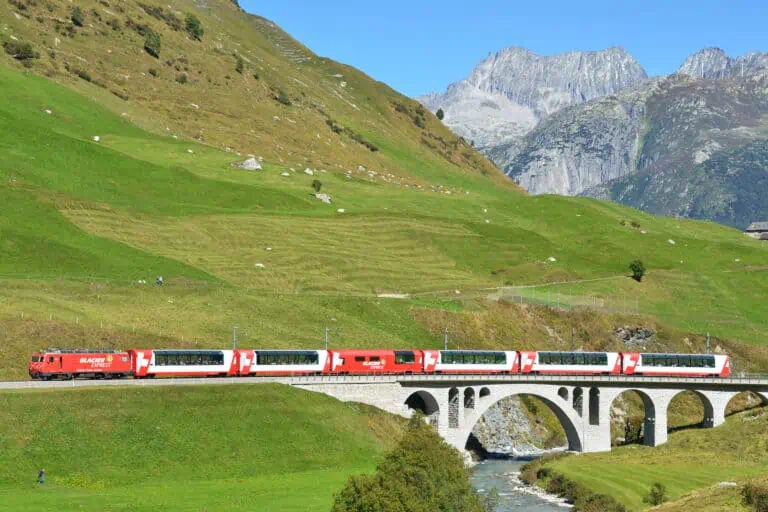
Glacier Express
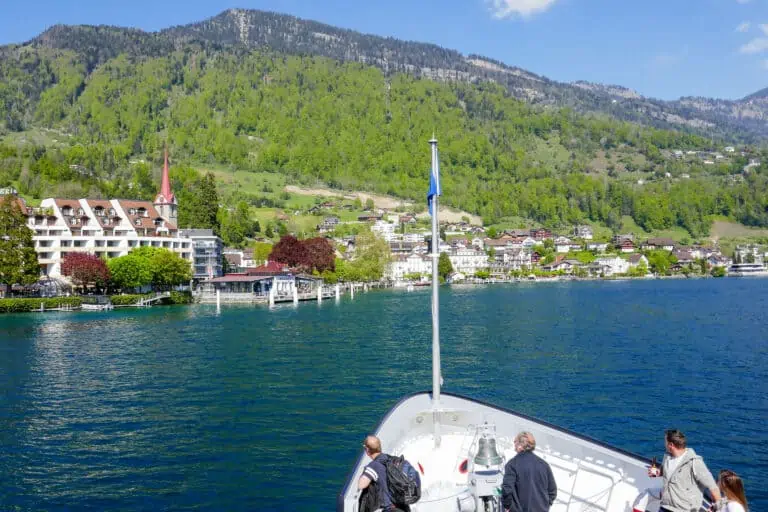
Boat Lake Lucerne
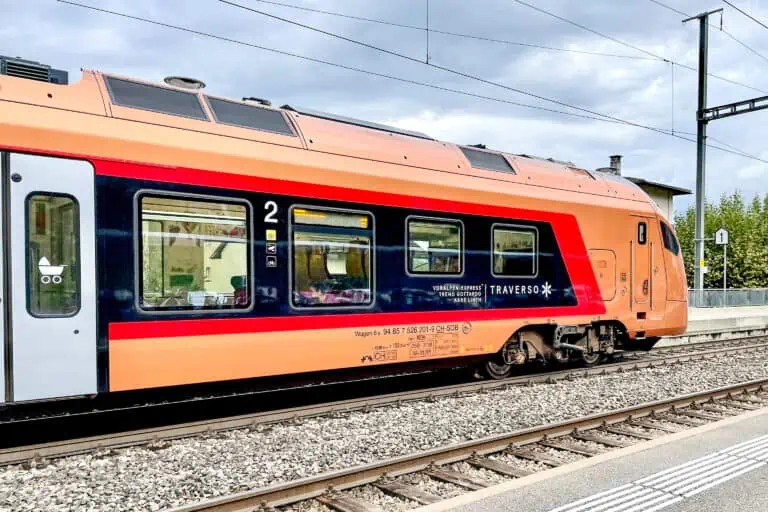
Voralpen-Express
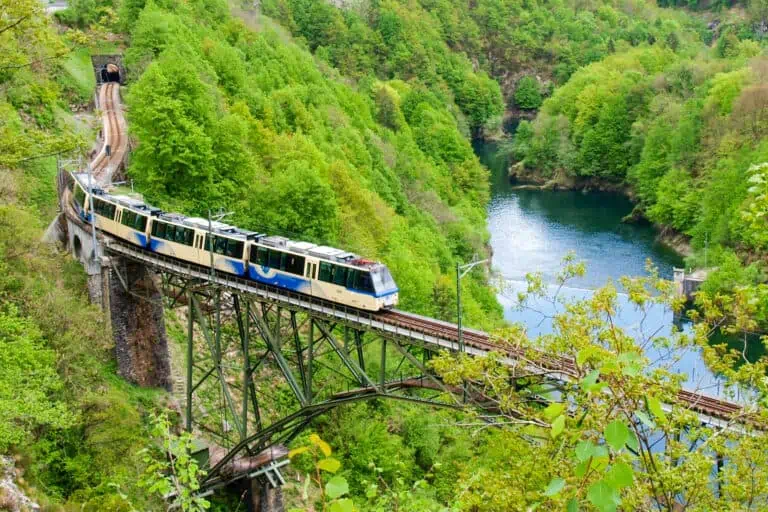
Centovalli Railway
More about Lake Lucerne, the Ticino and Lugano 
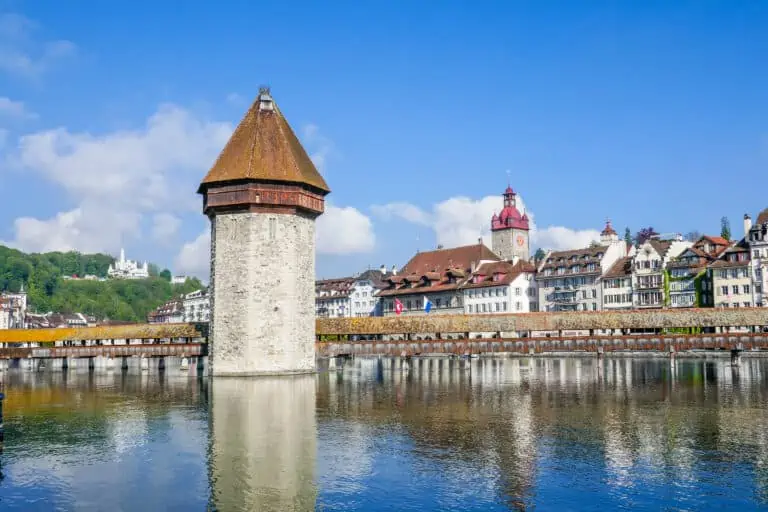
Lucerne
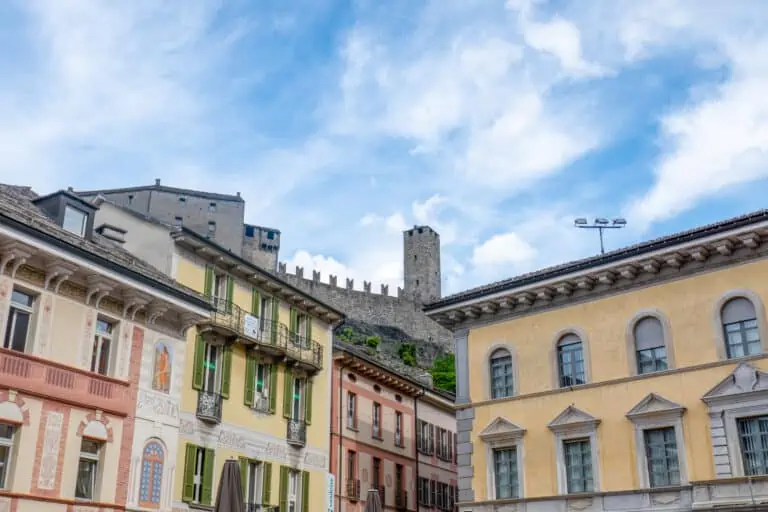
Bellinzona
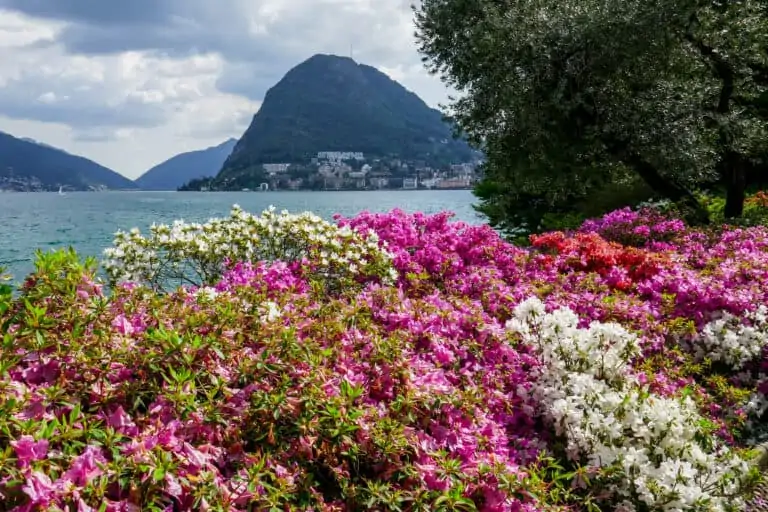
Lugano
